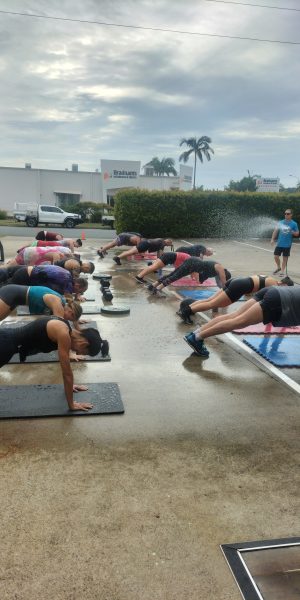Come on in for a “FUN” Surprise.
Congratulations to our amazing Masters League crew. You guys have been nothing but inspirational these past 4 weeks. So many personal achievements – and always bringing that extra 10%.
More Stories

Each year, we present the following awards to celebrate members of our community who have demonstrated significant achievements and contributed in meaningful ways. We are incredibly grateful to be surrounded by such an exceptional group, which makes choosing recipients harder every year. I’m sure you’ll agree that the athletes recognised below are truly deserving. May we continue to bring out the best in one another in 2026. TOP ATTENDANCE Each year this title is closely contested, but in 2025 we had a clear standout.2025 – LYDIA with 204 sessions COMMUNITY AWARD This award recognizes someone who consistently demonstrates selfless support for others.This year’s recipient embraced every aspect of our community—stepping up as an Open team captain, providing encouragement throughout the Spring Challenge, looking out for everyone, and often being the last person standing at events to ensure the whole crew gets home safely. 2025 – NICOLEThank you for everything you do for our community. NEW & IMPROVED Awarded to a newer member who has shown significant improvement in movement quality, health, and overall fitness—reflecting their dedication to growth. After years of gentle persuasion, he finally joined us, officially marrying into the Coastal CrossFit family. Since then, he has gone from strength to strength, hitting PBs what feels like every week. We’re excited to continue supporting your health and fitness journey – JOSH INSPIRATION AWARD Presented to someone who inspires those around them by challenging themselves to live a healthier, more functional, and fulfilling life. Training right up until pregnancy, then returning soon after her little boy arrived, she has embraced the challenges of motherhood while continuing to prioritise her health. A true example of training for life and setting an incredible example for Ted and Elias. Congratulations, Sally, and thank you for being an ongoing source of inspiration.2025 – SALLY ATHLETIC ACHIEVEMENT This award recognises an individual who has demonstrated exceptional improvement throughout the year—someone who embraces coaching, works on their weaknesses, and consistently gives their best. It’s an honor to witness the growth of our athletes, and many were deserving of this award. However, one athlete truly stood out this year for her confidence, her willingness to challenge herself, and her overall athletic development in 2025.2025 – MEL SPIRIT OF COASTAL This award goes to the individual who embodies the attributes we value most: discipline, coachability, positivity, humility, a focus on health and wellbeing, and unwavering support for the community. It is not about being the top performer, but about representing what Coastal stands for. From the moment you walked through our doors, you became a valued part of our community. Your positivity, energy, and genuine nature reflect everything we love about Coastal. 2025 – LINTON

Wishing everyone a safe and merry festive season.We will be running under a reduced timetable from the 24th Dec, returning to full schedule on the 5th Jan 2026. Check below for our Christmas Time table. The WOD will commence at the start of the session, Ie. 6:30am & 4:30pm. Open gym will be available throughout the entire 1.5hour time block. DROP INS- We welcome visiting CrossFitters over this time- please book a session via Mindbody or contact Marie 0432710684 to book a spot.Drop In rates- $20 casual class$60 Weekly unlimited

FREE Trial Week 5:30pm
FREE WEEK TRIAL — 5:30PM at Coastal CrossFit!Thinking about trying CrossFit but not sure where to begin?Start now — before the Christmas holidays — and build the momentum you need to finish the year strong. Why most people don’t start CrossFit (and why you absolutely can): Join us for a week — you will only benefit.Don’t wait for the New Year — start now, feel incredible heading into Christmas, and set the tone for 2026. Come try your free week at Coastal CrossFit — 5:30pm.See you there! Sign up via Mindbody or contact Marie 0432710684 /E: Coastal.crossfit.qld@gmail.comWe look forward to meeting you.

When: SATURDAY 6th DECEMBER We have a day of FAMILY FUN (join us in one or all) The PLAN-10am – 11amCoolum Aqua Fun Park – (Book your own tickets)Bring the Family- the more the merrier!! 3pm- 5pmBareFoot bowls – $10 per person (pay on the day)Club Kawana then, Join us at the Gym for a great night (More details to come). I will create individual events for each activity so we know who/how many to expect.Looking forward to a great day/night of celebrations with you all!!!

SPACE AVAILABLE FOR RENT – COASTAL CROSSFIT We have an upstairs space available for rent, ideal for health and fitness related services, such as massage, physio, recovery practitioners, and more. Approx. 8m x 5m, with flexible configuration Located directly beside our member recovery area (sauna, boots, mobility) — access may be included in lease options. Business must be suitable to operate alongside a CrossFit gym environment Why This Space? Built-in exposureDaily visibility to our active Coastal CrossFit community — motivated members focused on performance, health and recovery. Prime Warana locationEasy access to Nicklin Way and convenient for clients, local workers and passersby. Established business hubPositioned among thriving local businesses with great visibility and foot traffic. Flexible layout (The space can be reconfigured to suit your service needs). If this sounds like the right fit, contact Marie on 0432 710 684 or email coastal.crossfit.qld@gmail.com

Virtuosity Challenge
The Virtuosity Challenge “Doing the common, uncommonly well.” We’re inviting you to push past the ordinary and achieve mastery in the fundamentals. The Virtuosity Challenge isn’t about chasing the flashiest lifts or the heaviest numbers—it’s about refining the basics and performing them with precision, consistency, and excellence. The Challenge: Why take part? By the end of the year, you’ll achieve virtuosity in your chosen movements—mastery through repetition, focus, and commitment. Members- commit on our Members Facebook Page.

🌊 Coastal CrossFit KIDS 🌊 Is your child ready to move, play, and grow stronger—both physically and mentally? Our Coastal CrossFit KIDS program is here to help! 🕒 Schedule: 🏋️ Coached by: Chloe Saliba – CrossFit Games athlete and international weightlifter! 🏋️♀️ With years of elite training experience, Chloe brings her passion and expertise to every Coastal CrossFit KIDS session. She makes fitness fun, engaging, and full of energy, and absolutely loves watching kids build confidence, master new skills, and grow stronger every week. Our program is suitable for all abilities, focusing on:✅ Building confidence✅ Making health & fitness fun✅ Teaching movement skills for life Give your child the gift of strength, confidence, and a love for fitness that will last a lifetime. 💪✨ 📩 Message us to book your child’s spot today!coastal.crossfit.qld@gmail.com0432710684

About Coastal CrossFit
🏋️♀️ About Coastal CrossFit Welcome to Coastal CrossFit — where fitness meets community, hard work meets laughter, and results come from doing the simple things well. Founded by Chris and Marie Saliba in 2009, Coastal CrossFit has been proudly serving the Sunshine Coast for over 16 years. As the region’s longest-running affiliates (original owners) we’ve stayed true to an old-school CrossFit vibe — authentic coaching, no fluff, and a community built on effort, humility, and consistency. We’re old school proud.What originally drew us to CrossFit is still what keeps us going today — real fitness, real people, and a community that cares.Our family lives and breathes fitness for life, and that passion flows through everything we do. 💪 Our Philosophy At Coastal, we believe in real fitness for real people.No gimmicks. No shortcuts. Just smart, functional training delivered with care and intention. We coach — properly.We provide 1:1 scaling and guidance for every athlete in every class. There’s no generic, one-size-fits-all approach here. We tailor each session to your goals, abilities, and experience. It doesn’t matter where you start — we’re all on our own journey, and we travel that path together.At Coastal, there’s no ego — just hard work and support. 🧠 Our Programming We write our own programming — always have, always will.Why? Because we know our athletes — their abilities, injuries, goals, and challenges. We also know our space, our equipment, and the local weather, and we use that knowledge to create smart, effective programming that truly fits our community. We program for the general population, with a focus on health, longevity, and overall wellbeing. Our goal is to help people move better, feel stronger, and live healthier — inside and outside the gym. Every workout has purpose. Every movement has intent.Our programming evolves with our people — not the latest trends. 👥 Our Community We’re more than a gym — we’re a family. Many of our members have been with us from day one, and we’re proud to have athletes who have stayed with us for years, growing stronger together. Our members come from all walks of life, training side by side and supporting each other through every rep and every season of life. Your ability, size, or background doesn’t matter. Once you walk through our doors, you’re supported and encouraged by the most amazing crew. We’ll challenge, support, and lift you up — helping you become the best version of yourself. The vibe? Old-school CrossFit — the kind where the whiteboard still matters. It’s where we record scores, share effort, celebrate wins, and keep each other accountable. Barbells clanging, music pumping, everyone cheering for the last person to finish — that’s Coastal. Here, effort is celebrated, progress is personal, and everyone is welcome. 🧑🏫 Our Coaches Led by Marie and Chris, our coaching team brings years of experience across CrossFit, Olympic weightlifting, and movement coaching.We focus on doing the basics exceptionally well — with an emphasis on movement quality, consistency, and longevity. Our coaches are a true part of our community. They train alongside our members, know each person’s strengths and challenges, and genuinely care. They lead by example — showing up, putting in the work, and supporting others to do the same. Expect hands-on coaching, honest feedback, and an approach that’s personal, practical, and focused on helping you move well and feel strong. Meet our coaches 🏠 Our Space Located at 1/12 Technology Drive, Warana, on the Parrearra Canal, our gym is built for purpose. You won’t find mirrors or fancy machines here — just quality equipment, open space, and an atmosphere built on hard work and genuine connection. We’re proudly fitted out with Maverick Strength & Conditioning Equipment — gear that grew from humble beginnings right here at Coastal CrossFit. It’s strong, functional, and made to handle real training. We are blessed with the most scenic run tracks around the canal and we’re just a short stroll from Warana Beach. We also have a Recovery Room for our members, featuring Endurance Recovery Boots and an Infrared Sauna — because we know recovery is just as important as effort in the gym. Our space is functional, friendly, and full of the kind of energy you can’t fake — a place where effort matters more than appearance, and community comes first. 🚀 Our Mission To help everyday people live stronger, healthier, more confident lives through functional fitness and community connection. We’re here to help you: No matter your age, background, or fitness level — you belong here.This is Coastal CrossFit: old-school values, real coaching, hands-on support, and a community that’s got your back. 👉 Ready to start? Come in for a free trial, meet the crew, and see what makes Coastal different. Written whiteboards, no ego — just hard work, support, and a community that feels like home.

WOD: Monday
Coastal CrossFit is back to full schedule from today.We hope you all had a great festive season!! It is time to get back into routine and get life back on track. We hope you have missed us!!! We are looking forward to getting our full crew back on board this week. A. Heavy Triple Push Jerk. B. Five rounds for time/load:10 Shoulder to Overhead (Maintain load)* 15 Pull-ups Rest 1 minute *(Choose a weight that allows for Heavy but unbroken reps) Photo: Christmas Eve fun. We will try this again in winter 😀

